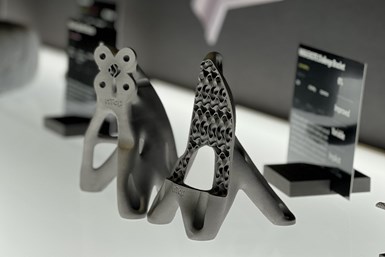Updated nTop Platform Advances AM Design, Simulations
The updated design and simulation solution builds upon nTop's core technologies and introduces new capabilities across four key themes — design, integration, scaling and adoption.
The company’s nTop 4 offers a holistic approach to design for additive manufacturing (DfAM), enabling engineers to deliver highly engineered AM parts for products to reach new levels of performance. Photo Credit: nTop
Engineering design software company nTop (formerly nTopology) has updated its flagship design and simulation solution to offer nTop 4. With a holistic approach to design for additive manufacturing (DfAM), nTop 4 is said to enable engineers to bring additive manufacturing (AM) to mainstream production. This release builds upon nTop’s core technologies and introduces new capabilities across four key themes — design, integration, scaling and adoption.
“At nTop, we have always believed that design is at the core of solving the world’s hardest engineering problems,” says Bradley Rothenberg, nTop co-founder and CEO. “nTop 4 marks the next stage of our journey, enabling engineers to deliver highly engineered AM parts for products to reach new levels of performance.”
The nTop 4’s Field Optimization is a generative design technology that helps engineers navigate the overwhelming number of design parameters introduced by complex engineering problems, accelerating decision-making and improving part performance. This feature layers a multiscale and multi-objective optimization engine on top of nTop’s core technology, resulting in a design tool that is both powerful and easy to implement, the company says.
The Field Optimization feature also introduces easy-to-use workflows enabling engineers to generate better-performing AM part designs for applications such as lightweighting, medical implants and industrial design. The company says it will continue developing capabilities of this new technology in future releases.
The integration element is said to eliminate data exchange bottlenecks with Implicit Interop. The Implicit Interop function is said to eliminate data exchange bottlenecks for even the most complex designs, enabling data transfer between nTop, manufacturing, CAD and CAE software in files sizing in the megabytes, not gigabytes.
The nTop 4 also includes nTop Core which is a developer library that makes it easy for partners to implement native Implicit Interop integrations and is already in use by nTop’s partner ecosystem. The nTop plugin for EOSPrint is the first Implicit Interop software connection which will be available with the upcoming release of EOSPrint 2.14 in June. The nTop Implicit File (.implicit) is an nTop file format used to directly exchange implicit geometry without meshing, resulting in smaller file sizes at lossless precision.
The nTop Automate enables users to multiply the impact of engineering resources by executing nTop workflows through a programmatic environment. In addition to the Windows deployment, nTop 4’s nTop Automate for Linux enables engineers to unlock more economical cloud computing or use available on-premise high-performance computing (HPC) resources.
The company is also looking to create value faster with its customer success programs to accelerate adoption and maximize impact in organizations of any size. The nTop Accelerate offers a range of one-to-one training services, custom workshops and design sprints to help nTop’s customers best meet their program objectives. The company also continues to invest in onboarding programs — such as nTop Learn, nTop’s online learning center — to ensure that engineers can deliver value as fast as possible.
- Learn more about nTop’s platform which offers a design and simulation solution for design, simulation and advanced manufacturing processes.
- Read about nTop’s 3.0 version of its AM Engineering Design solution that offers an opt-in feature enabling nTop users to experience an instant 10 to to 100 times performance boost when visualizing workflows that use complex field-driven geometry.
- Check out this article about Stratasys and nTopology’s fixture software that simplifies AM modeling and design. The FDM Assembly Fixture Generator automates design of jigs and fixtures, enabling engineers to quickly turn a part file into a ready-to-print fixture with a simple drag-and-drop function.
Related Content
Semiconductors, Tungsten, AM Affordability and More from Formnext 2024: AM Radio #56
The trade show included increased applications for the semiconductor market, machine launches and technology advances aimed at cost cutting, plenty of LFAM and more. Listen to our conversation on Formnext 2024.
Read MoreOvercoming the Bottleneck to Customized Manufacturing: Quoting
Spokbee’s software-as-a-service platform is shaving months off of the quoting and pricing process for 3D printed and other types of configurable products.
Read MoreRobot Vs. Gantry for Large-Format Additive Manufacturing (Includes Video)
Additive Engineering Solutions, specialist at 3D printing very large parts and tools on gantry machines, now also uses a robot for large-format AM. Here is how the robot compares.
Read More3D Printed Cutting Tool for Large Transmission Part: The Cool Parts Show Bonus
A boring tool that was once 30 kg challenged the performance of the machining center using it. The replacement tool is 11.5 kg, and more efficient as well, thanks to generative design.
Read MoreRead Next
3D Printed Polymer EOAT Increases Safety of Cobots
Contract manufacturer Anubis 3D applies polymer 3D printing processes to manufacture cobot tooling that is lightweight, smooth and safer for human interaction.
Read MoreProfilometry-Based Indentation Plastometry (PIP) as an Alternative to Standard Tensile Testing
UK-based Plastometrex offers a benchtop testing device utilizing PIP to quickly and easily analyze the yield strength, tensile strength and uniform elongation of samples and even printed parts. The solution is particularly useful for additive manufacturing.
Read MoreBike Manufacturer Uses Additive Manufacturing to Create Lighter, More Complex, Customized Parts
Titanium bike frame manufacturer Hanglun Technology mixes precision casting with 3D printing to create bikes that offer increased speed and reduced turbulence during long-distance rides, offering a smoother, faster and more efficient cycling experience.
Read More





















